Quality Improvement in Healthcare: Strategies and Challenges
VerifiedAdded on 2022/11/07
|10
|2573
|366
Report
AI Summary
This report examines quality improvement in healthcare, highlighting the efforts to enhance patient safety and communication within healthcare systems. It discusses the need for improved healthcare financing and cost-effective interventions, as well as the current strategies for strengthening effective communication and ensuring transparent accountability. The report also addresses the challenges, such as lack of resources and effective management, that can hinder the progress of these efforts. It provides insights into how to address these challenges, including strong leadership, consistent commitment to improvement, and stakeholder engagement to maximize the continuous enhancement of the quality and safety of health service provision. The report references various research studies and reports to support its arguments, emphasizing the dynamic and multifaceted nature of quality and safety enhancement in healthcare.
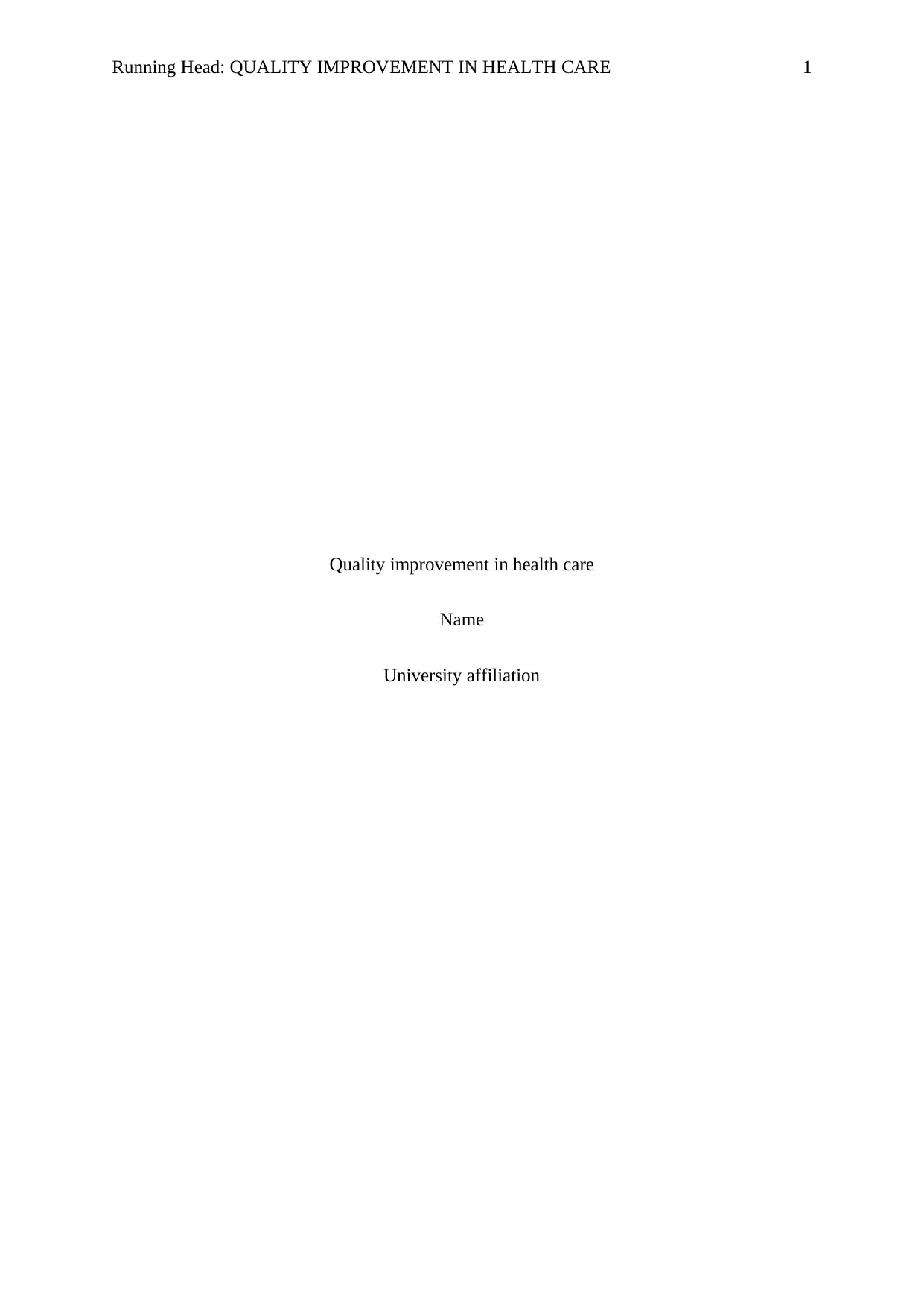
Running Head: QUALITY IMPROVEMENT IN HEALTH CARE 1
Quality improvement in health care
Name
University affiliation
Quality improvement in health care
Name
University affiliation
Paraphrase This Document
Need a fresh take? Get an instant paraphrase of this document with our AI Paraphraser

QUALITY IMPROVEMENT IN HEALTH CARE 2
Quality improvement in health care
Over the past decade, health foundations have shown their efforts in making
healthcare safer by funding thousands of people working in different settings from hospitals
to care homes. There have also been cases of specific causes of harm within the healthcare
system where front-line teams such as the government, organization, team and individuals
working in the organization can use quality improvement methods to address the problems.
Such efforts should be made to reduce the number of patients harmed by safety and quality
problems. However, despite the efforts made to improve the quality of healthcare in terms of
promoting more transparent accountability and effective commination between healthcare
providers and their patients, the gap between basic as well as operational action still remains
significant. Healthcare systems need more resources, better health financing schemes and
cost-effective interventions. This paper aim at discussing current strategies that have been put
in place to strengthen effective communication. Also, there is clearer accountability as well
as the challenges that can threaten the outcomes of such efforts.
Need for maintaining and improving the quality and safety of health services
A report produced by the institute of medication commission in regards to excellent
healthcare US Department of Health and Human Services (2014) outlined that millions of
patients across the world fail to receive adequate healthcare services. This happened every
year due to lack of more transparent accountability and effective communication between
nurses and patients (US Department of Health and Human Services, 2014). Additionally, the
US Department of Health and Human Services outlined that most healthcare systems around
the world fail to utilize their resources for better use. Other researchers at the RAND
Corporation developed that countless types of medical mistakes due to lack of clearer
accountability and lack of effective communication result in the subsequent prerequisite for
Quality improvement in health care
Over the past decade, health foundations have shown their efforts in making
healthcare safer by funding thousands of people working in different settings from hospitals
to care homes. There have also been cases of specific causes of harm within the healthcare
system where front-line teams such as the government, organization, team and individuals
working in the organization can use quality improvement methods to address the problems.
Such efforts should be made to reduce the number of patients harmed by safety and quality
problems. However, despite the efforts made to improve the quality of healthcare in terms of
promoting more transparent accountability and effective commination between healthcare
providers and their patients, the gap between basic as well as operational action still remains
significant. Healthcare systems need more resources, better health financing schemes and
cost-effective interventions. This paper aim at discussing current strategies that have been put
in place to strengthen effective communication. Also, there is clearer accountability as well
as the challenges that can threaten the outcomes of such efforts.
Need for maintaining and improving the quality and safety of health services
A report produced by the institute of medication commission in regards to excellent
healthcare US Department of Health and Human Services (2014) outlined that millions of
patients across the world fail to receive adequate healthcare services. This happened every
year due to lack of more transparent accountability and effective communication between
nurses and patients (US Department of Health and Human Services, 2014). Additionally, the
US Department of Health and Human Services outlined that most healthcare systems around
the world fail to utilize their resources for better use. Other researchers at the RAND
Corporation developed that countless types of medical mistakes due to lack of clearer
accountability and lack of effective communication result in the subsequent prerequisite for
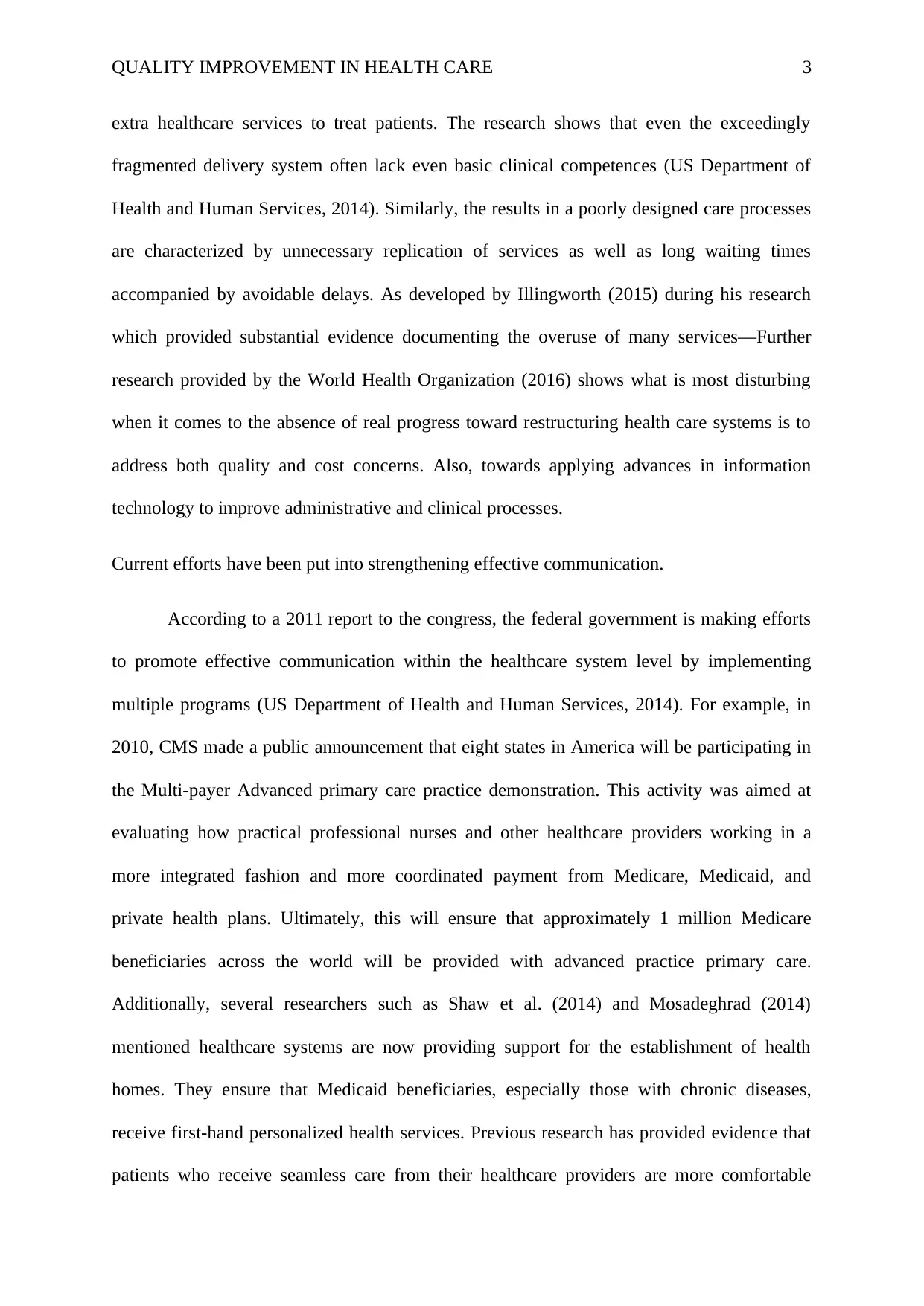
QUALITY IMPROVEMENT IN HEALTH CARE 3
extra healthcare services to treat patients. The research shows that even the exceedingly
fragmented delivery system often lack even basic clinical competences (US Department of
Health and Human Services, 2014). Similarly, the results in a poorly designed care processes
are characterized by unnecessary replication of services as well as long waiting times
accompanied by avoidable delays. As developed by Illingworth (2015) during his research
which provided substantial evidence documenting the overuse of many services—Further
research provided by the World Health Organization (2016) shows what is most disturbing
when it comes to the absence of real progress toward restructuring health care systems is to
address both quality and cost concerns. Also, towards applying advances in information
technology to improve administrative and clinical processes.
Current efforts have been put into strengthening effective communication.
According to a 2011 report to the congress, the federal government is making efforts
to promote effective communication within the healthcare system level by implementing
multiple programs (US Department of Health and Human Services, 2014). For example, in
2010, CMS made a public announcement that eight states in America will be participating in
the Multi-payer Advanced primary care practice demonstration. This activity was aimed at
evaluating how practical professional nurses and other healthcare providers working in a
more integrated fashion and more coordinated payment from Medicare, Medicaid, and
private health plans. Ultimately, this will ensure that approximately 1 million Medicare
beneficiaries across the world will be provided with advanced practice primary care.
Additionally, several researchers such as Shaw et al. (2014) and Mosadeghrad (2014)
mentioned healthcare systems are now providing support for the establishment of health
homes. They ensure that Medicaid beneficiaries, especially those with chronic diseases,
receive first-hand personalized health services. Previous research has provided evidence that
patients who receive seamless care from their healthcare providers are more comfortable
extra healthcare services to treat patients. The research shows that even the exceedingly
fragmented delivery system often lack even basic clinical competences (US Department of
Health and Human Services, 2014). Similarly, the results in a poorly designed care processes
are characterized by unnecessary replication of services as well as long waiting times
accompanied by avoidable delays. As developed by Illingworth (2015) during his research
which provided substantial evidence documenting the overuse of many services—Further
research provided by the World Health Organization (2016) shows what is most disturbing
when it comes to the absence of real progress toward restructuring health care systems is to
address both quality and cost concerns. Also, towards applying advances in information
technology to improve administrative and clinical processes.
Current efforts have been put into strengthening effective communication.
According to a 2011 report to the congress, the federal government is making efforts
to promote effective communication within the healthcare system level by implementing
multiple programs (US Department of Health and Human Services, 2014). For example, in
2010, CMS made a public announcement that eight states in America will be participating in
the Multi-payer Advanced primary care practice demonstration. This activity was aimed at
evaluating how practical professional nurses and other healthcare providers working in a
more integrated fashion and more coordinated payment from Medicare, Medicaid, and
private health plans. Ultimately, this will ensure that approximately 1 million Medicare
beneficiaries across the world will be provided with advanced practice primary care.
Additionally, several researchers such as Shaw et al. (2014) and Mosadeghrad (2014)
mentioned healthcare systems are now providing support for the establishment of health
homes. They ensure that Medicaid beneficiaries, especially those with chronic diseases,
receive first-hand personalized health services. Previous research has provided evidence that
patients who receive seamless care from their healthcare providers are more comfortable
⊘ This is a preview!⊘
Do you want full access?
Subscribe today to unlock all pages.

Trusted by 1+ million students worldwide
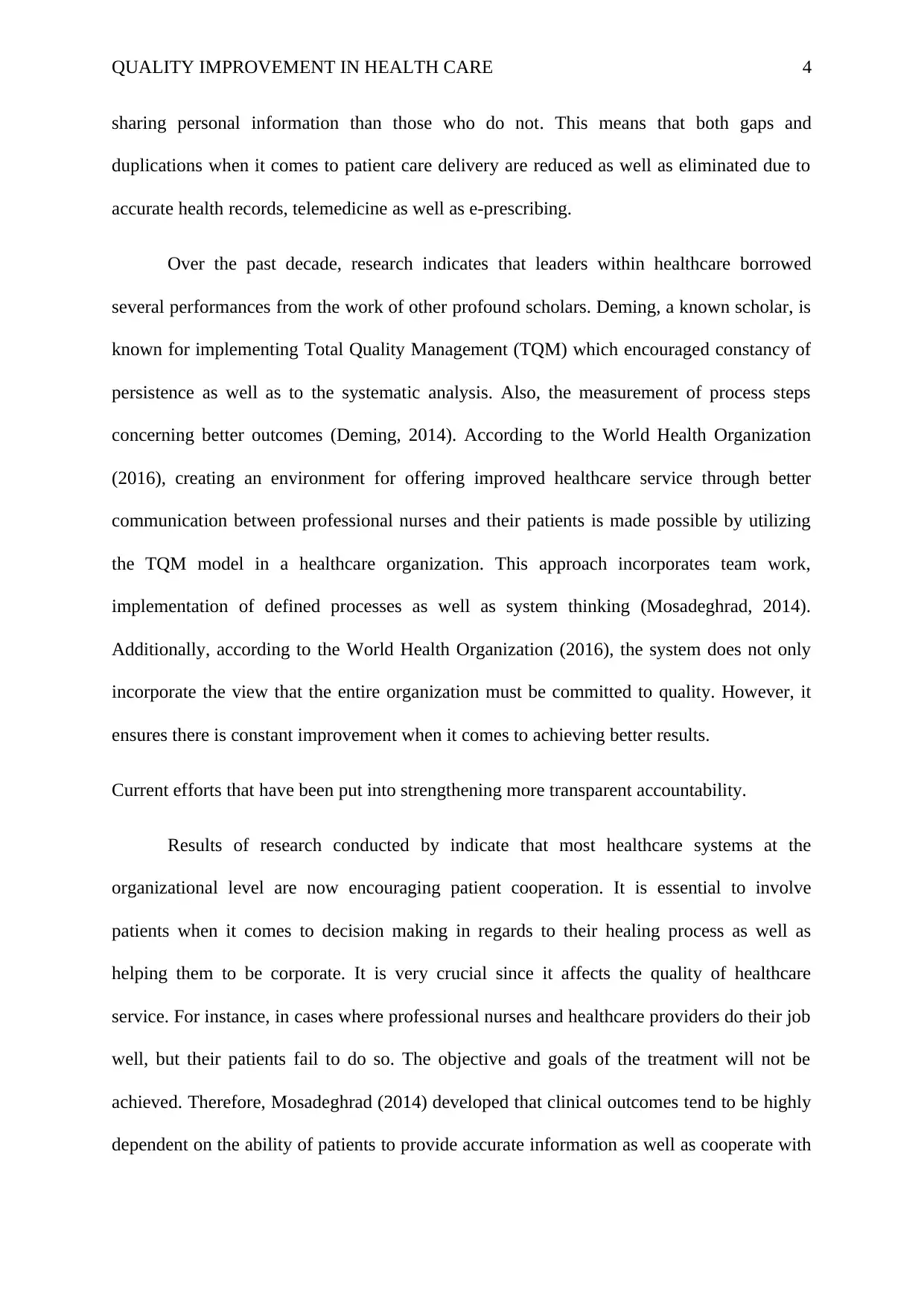
QUALITY IMPROVEMENT IN HEALTH CARE 4
sharing personal information than those who do not. This means that both gaps and
duplications when it comes to patient care delivery are reduced as well as eliminated due to
accurate health records, telemedicine as well as e-prescribing.
Over the past decade, research indicates that leaders within healthcare borrowed
several performances from the work of other profound scholars. Deming, a known scholar, is
known for implementing Total Quality Management (TQM) which encouraged constancy of
persistence as well as to the systematic analysis. Also, the measurement of process steps
concerning better outcomes (Deming, 2014). According to the World Health Organization
(2016), creating an environment for offering improved healthcare service through better
communication between professional nurses and their patients is made possible by utilizing
the TQM model in a healthcare organization. This approach incorporates team work,
implementation of defined processes as well as system thinking (Mosadeghrad, 2014).
Additionally, according to the World Health Organization (2016), the system does not only
incorporate the view that the entire organization must be committed to quality. However, it
ensures there is constant improvement when it comes to achieving better results.
Current efforts that have been put into strengthening more transparent accountability.
Results of research conducted by indicate that most healthcare systems at the
organizational level are now encouraging patient cooperation. It is essential to involve
patients when it comes to decision making in regards to their healing process as well as
helping them to be corporate. It is very crucial since it affects the quality of healthcare
service. For instance, in cases where professional nurses and healthcare providers do their job
well, but their patients fail to do so. The objective and goals of the treatment will not be
achieved. Therefore, Mosadeghrad (2014) developed that clinical outcomes tend to be highly
dependent on the ability of patients to provide accurate information as well as cooperate with
sharing personal information than those who do not. This means that both gaps and
duplications when it comes to patient care delivery are reduced as well as eliminated due to
accurate health records, telemedicine as well as e-prescribing.
Over the past decade, research indicates that leaders within healthcare borrowed
several performances from the work of other profound scholars. Deming, a known scholar, is
known for implementing Total Quality Management (TQM) which encouraged constancy of
persistence as well as to the systematic analysis. Also, the measurement of process steps
concerning better outcomes (Deming, 2014). According to the World Health Organization
(2016), creating an environment for offering improved healthcare service through better
communication between professional nurses and their patients is made possible by utilizing
the TQM model in a healthcare organization. This approach incorporates team work,
implementation of defined processes as well as system thinking (Mosadeghrad, 2014).
Additionally, according to the World Health Organization (2016), the system does not only
incorporate the view that the entire organization must be committed to quality. However, it
ensures there is constant improvement when it comes to achieving better results.
Current efforts that have been put into strengthening more transparent accountability.
Results of research conducted by indicate that most healthcare systems at the
organizational level are now encouraging patient cooperation. It is essential to involve
patients when it comes to decision making in regards to their healing process as well as
helping them to be corporate. It is very crucial since it affects the quality of healthcare
service. For instance, in cases where professional nurses and healthcare providers do their job
well, but their patients fail to do so. The objective and goals of the treatment will not be
achieved. Therefore, Mosadeghrad (2014) developed that clinical outcomes tend to be highly
dependent on the ability of patients to provide accurate information as well as cooperate with
Paraphrase This Document
Need a fresh take? Get an instant paraphrase of this document with our AI Paraphraser
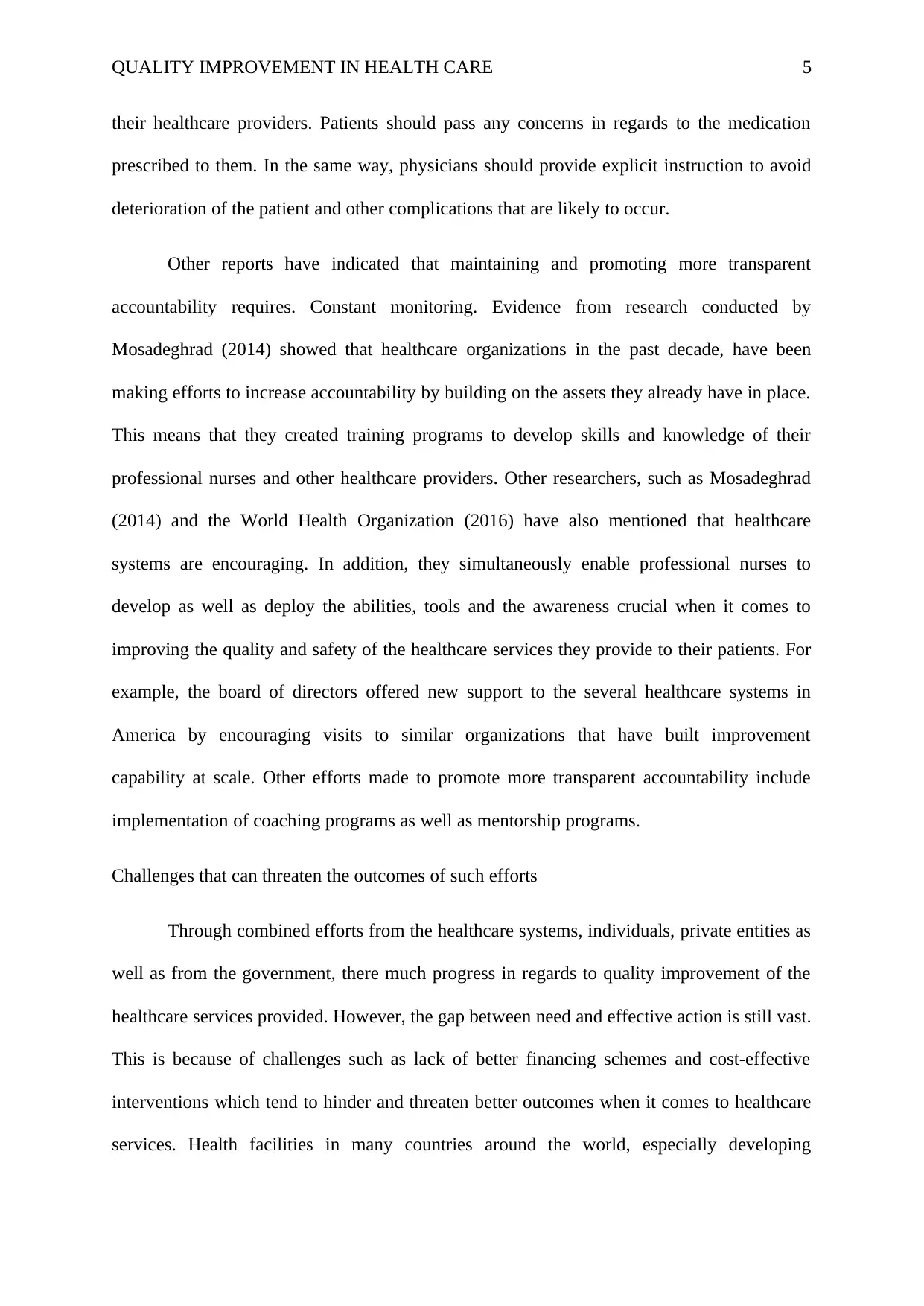
QUALITY IMPROVEMENT IN HEALTH CARE 5
their healthcare providers. Patients should pass any concerns in regards to the medication
prescribed to them. In the same way, physicians should provide explicit instruction to avoid
deterioration of the patient and other complications that are likely to occur.
Other reports have indicated that maintaining and promoting more transparent
accountability requires. Constant monitoring. Evidence from research conducted by
Mosadeghrad (2014) showed that healthcare organizations in the past decade, have been
making efforts to increase accountability by building on the assets they already have in place.
This means that they created training programs to develop skills and knowledge of their
professional nurses and other healthcare providers. Other researchers, such as Mosadeghrad
(2014) and the World Health Organization (2016) have also mentioned that healthcare
systems are encouraging. In addition, they simultaneously enable professional nurses to
develop as well as deploy the abilities, tools and the awareness crucial when it comes to
improving the quality and safety of the healthcare services they provide to their patients. For
example, the board of directors offered new support to the several healthcare systems in
America by encouraging visits to similar organizations that have built improvement
capability at scale. Other efforts made to promote more transparent accountability include
implementation of coaching programs as well as mentorship programs.
Challenges that can threaten the outcomes of such efforts
Through combined efforts from the healthcare systems, individuals, private entities as
well as from the government, there much progress in regards to quality improvement of the
healthcare services provided. However, the gap between need and effective action is still vast.
This is because of challenges such as lack of better financing schemes and cost-effective
interventions which tend to hinder and threaten better outcomes when it comes to healthcare
services. Health facilities in many countries around the world, especially developing
their healthcare providers. Patients should pass any concerns in regards to the medication
prescribed to them. In the same way, physicians should provide explicit instruction to avoid
deterioration of the patient and other complications that are likely to occur.
Other reports have indicated that maintaining and promoting more transparent
accountability requires. Constant monitoring. Evidence from research conducted by
Mosadeghrad (2014) showed that healthcare organizations in the past decade, have been
making efforts to increase accountability by building on the assets they already have in place.
This means that they created training programs to develop skills and knowledge of their
professional nurses and other healthcare providers. Other researchers, such as Mosadeghrad
(2014) and the World Health Organization (2016) have also mentioned that healthcare
systems are encouraging. In addition, they simultaneously enable professional nurses to
develop as well as deploy the abilities, tools and the awareness crucial when it comes to
improving the quality and safety of the healthcare services they provide to their patients. For
example, the board of directors offered new support to the several healthcare systems in
America by encouraging visits to similar organizations that have built improvement
capability at scale. Other efforts made to promote more transparent accountability include
implementation of coaching programs as well as mentorship programs.
Challenges that can threaten the outcomes of such efforts
Through combined efforts from the healthcare systems, individuals, private entities as
well as from the government, there much progress in regards to quality improvement of the
healthcare services provided. However, the gap between need and effective action is still vast.
This is because of challenges such as lack of better financing schemes and cost-effective
interventions which tend to hinder and threaten better outcomes when it comes to healthcare
services. Health facilities in many countries around the world, especially developing
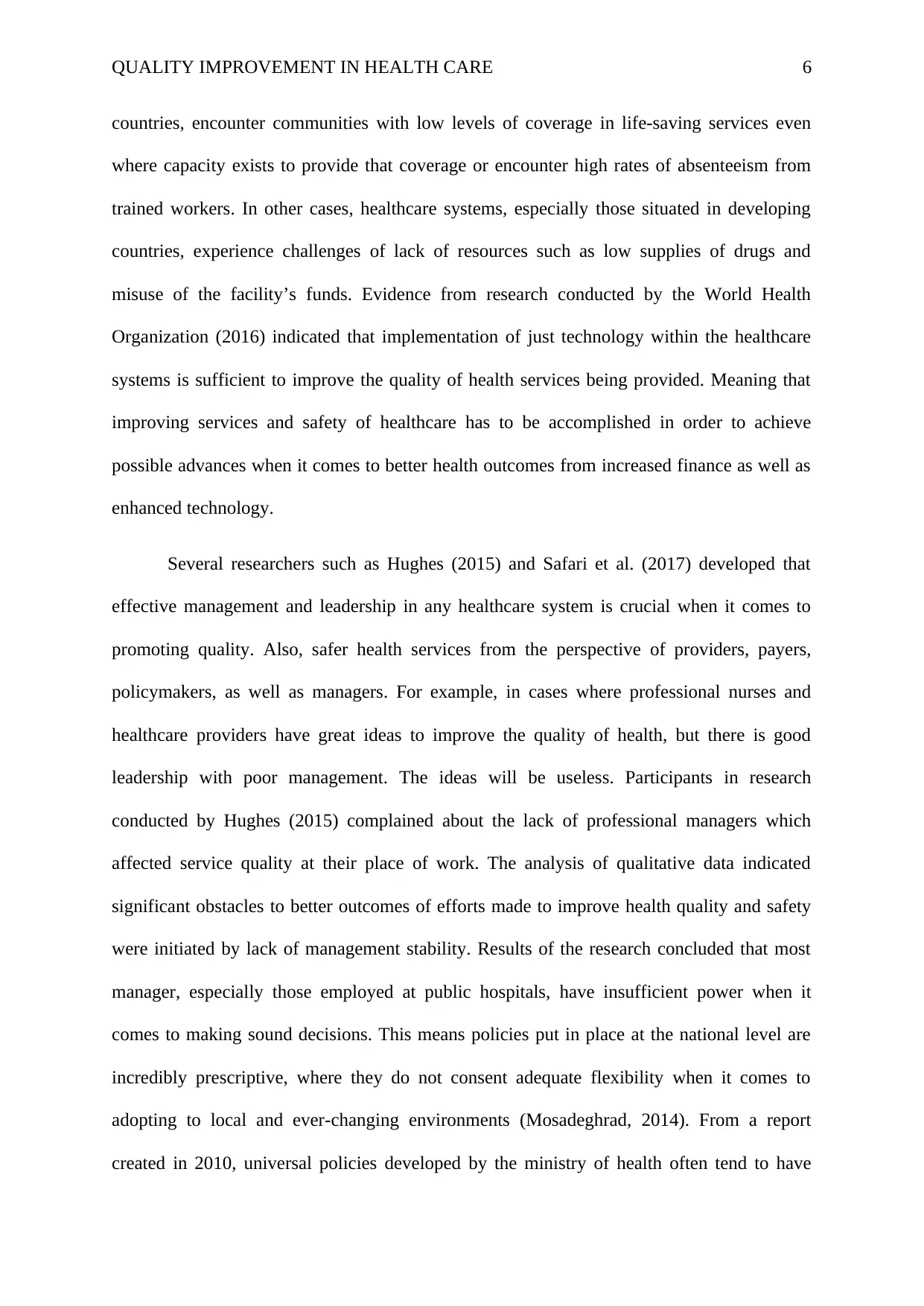
QUALITY IMPROVEMENT IN HEALTH CARE 6
countries, encounter communities with low levels of coverage in life-saving services even
where capacity exists to provide that coverage or encounter high rates of absenteeism from
trained workers. In other cases, healthcare systems, especially those situated in developing
countries, experience challenges of lack of resources such as low supplies of drugs and
misuse of the facility’s funds. Evidence from research conducted by the World Health
Organization (2016) indicated that implementation of just technology within the healthcare
systems is sufficient to improve the quality of health services being provided. Meaning that
improving services and safety of healthcare has to be accomplished in order to achieve
possible advances when it comes to better health outcomes from increased finance as well as
enhanced technology.
Several researchers such as Hughes (2015) and Safari et al. (2017) developed that
effective management and leadership in any healthcare system is crucial when it comes to
promoting quality. Also, safer health services from the perspective of providers, payers,
policymakers, as well as managers. For example, in cases where professional nurses and
healthcare providers have great ideas to improve the quality of health, but there is good
leadership with poor management. The ideas will be useless. Participants in research
conducted by Hughes (2015) complained about the lack of professional managers which
affected service quality at their place of work. The analysis of qualitative data indicated
significant obstacles to better outcomes of efforts made to improve health quality and safety
were initiated by lack of management stability. Results of the research concluded that most
manager, especially those employed at public hospitals, have insufficient power when it
comes to making sound decisions. This means policies put in place at the national level are
incredibly prescriptive, where they do not consent adequate flexibility when it comes to
adopting to local and ever-changing environments (Mosadeghrad, 2014). From a report
created in 2010, universal policies developed by the ministry of health often tend to have
countries, encounter communities with low levels of coverage in life-saving services even
where capacity exists to provide that coverage or encounter high rates of absenteeism from
trained workers. In other cases, healthcare systems, especially those situated in developing
countries, experience challenges of lack of resources such as low supplies of drugs and
misuse of the facility’s funds. Evidence from research conducted by the World Health
Organization (2016) indicated that implementation of just technology within the healthcare
systems is sufficient to improve the quality of health services being provided. Meaning that
improving services and safety of healthcare has to be accomplished in order to achieve
possible advances when it comes to better health outcomes from increased finance as well as
enhanced technology.
Several researchers such as Hughes (2015) and Safari et al. (2017) developed that
effective management and leadership in any healthcare system is crucial when it comes to
promoting quality. Also, safer health services from the perspective of providers, payers,
policymakers, as well as managers. For example, in cases where professional nurses and
healthcare providers have great ideas to improve the quality of health, but there is good
leadership with poor management. The ideas will be useless. Participants in research
conducted by Hughes (2015) complained about the lack of professional managers which
affected service quality at their place of work. The analysis of qualitative data indicated
significant obstacles to better outcomes of efforts made to improve health quality and safety
were initiated by lack of management stability. Results of the research concluded that most
manager, especially those employed at public hospitals, have insufficient power when it
comes to making sound decisions. This means policies put in place at the national level are
incredibly prescriptive, where they do not consent adequate flexibility when it comes to
adopting to local and ever-changing environments (Mosadeghrad, 2014). From a report
created in 2010, universal policies developed by the ministry of health often tend to have
⊘ This is a preview!⊘
Do you want full access?
Subscribe today to unlock all pages.

Trusted by 1+ million students worldwide
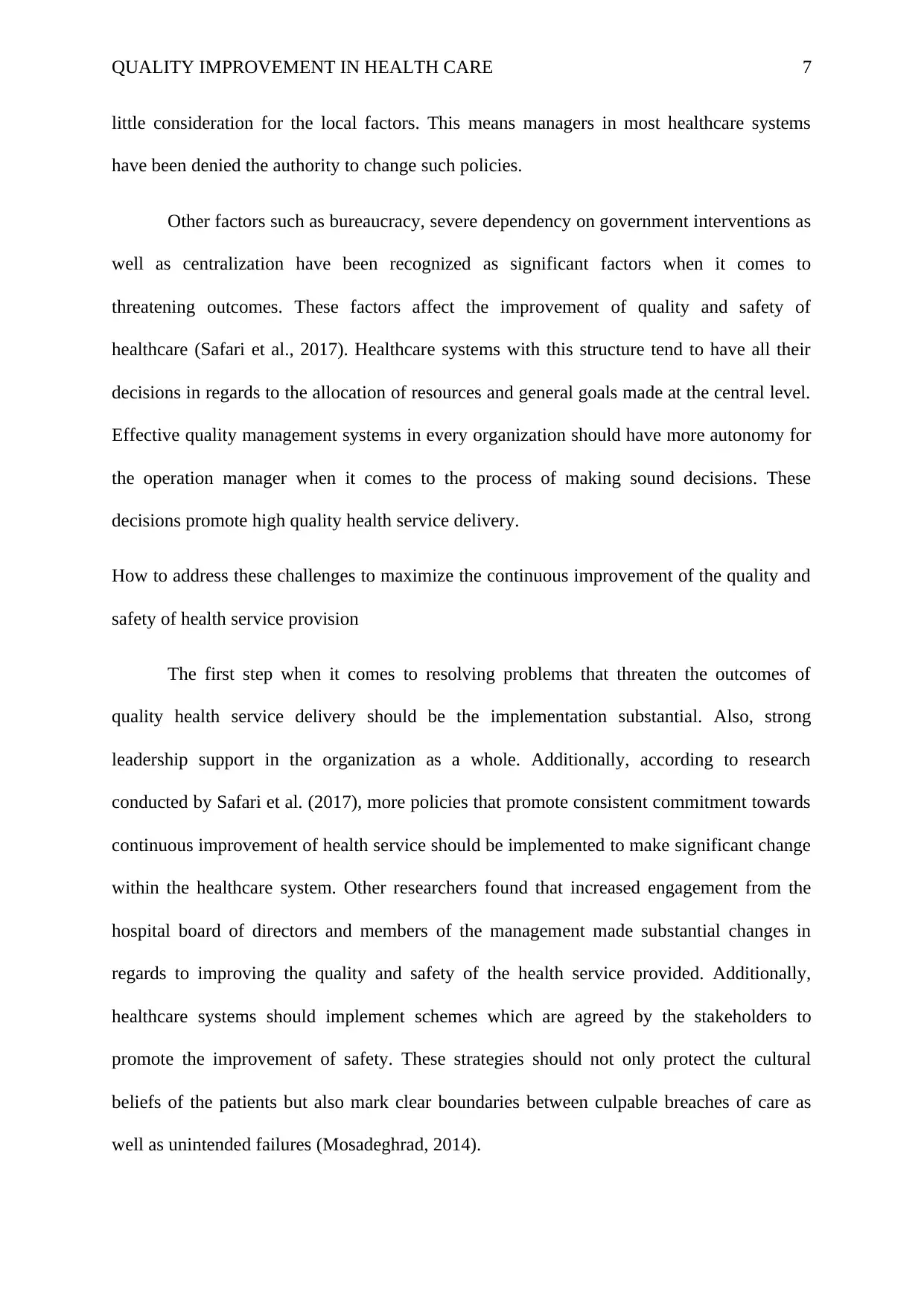
QUALITY IMPROVEMENT IN HEALTH CARE 7
little consideration for the local factors. This means managers in most healthcare systems
have been denied the authority to change such policies.
Other factors such as bureaucracy, severe dependency on government interventions as
well as centralization have been recognized as significant factors when it comes to
threatening outcomes. These factors affect the improvement of quality and safety of
healthcare (Safari et al., 2017). Healthcare systems with this structure tend to have all their
decisions in regards to the allocation of resources and general goals made at the central level.
Effective quality management systems in every organization should have more autonomy for
the operation manager when it comes to the process of making sound decisions. These
decisions promote high quality health service delivery.
How to address these challenges to maximize the continuous improvement of the quality and
safety of health service provision
The first step when it comes to resolving problems that threaten the outcomes of
quality health service delivery should be the implementation substantial. Also, strong
leadership support in the organization as a whole. Additionally, according to research
conducted by Safari et al. (2017), more policies that promote consistent commitment towards
continuous improvement of health service should be implemented to make significant change
within the healthcare system. Other researchers found that increased engagement from the
hospital board of directors and members of the management made substantial changes in
regards to improving the quality and safety of the health service provided. Additionally,
healthcare systems should implement schemes which are agreed by the stakeholders to
promote the improvement of safety. These strategies should not only protect the cultural
beliefs of the patients but also mark clear boundaries between culpable breaches of care as
well as unintended failures (Mosadeghrad, 2014).
little consideration for the local factors. This means managers in most healthcare systems
have been denied the authority to change such policies.
Other factors such as bureaucracy, severe dependency on government interventions as
well as centralization have been recognized as significant factors when it comes to
threatening outcomes. These factors affect the improvement of quality and safety of
healthcare (Safari et al., 2017). Healthcare systems with this structure tend to have all their
decisions in regards to the allocation of resources and general goals made at the central level.
Effective quality management systems in every organization should have more autonomy for
the operation manager when it comes to the process of making sound decisions. These
decisions promote high quality health service delivery.
How to address these challenges to maximize the continuous improvement of the quality and
safety of health service provision
The first step when it comes to resolving problems that threaten the outcomes of
quality health service delivery should be the implementation substantial. Also, strong
leadership support in the organization as a whole. Additionally, according to research
conducted by Safari et al. (2017), more policies that promote consistent commitment towards
continuous improvement of health service should be implemented to make significant change
within the healthcare system. Other researchers found that increased engagement from the
hospital board of directors and members of the management made substantial changes in
regards to improving the quality and safety of the health service provided. Additionally,
healthcare systems should implement schemes which are agreed by the stakeholders to
promote the improvement of safety. These strategies should not only protect the cultural
beliefs of the patients but also mark clear boundaries between culpable breaches of care as
well as unintended failures (Mosadeghrad, 2014).
Paraphrase This Document
Need a fresh take? Get an instant paraphrase of this document with our AI Paraphraser

QUALITY IMPROVEMENT IN HEALTH CARE 8
Conclusion
It is evident from different researchers that health care complexity is a challenging
area thus requires guidance and cooperation from various bodies. In addition, this area is
being developed slowly but steadily by the body of knowledge, which according to several
researchers such as Safari et al. (2017) and Mosadeghrad (2014) could be due to the sustained
predicament. It also answers as to whether a quality improvement inventiveness is just that or
whether it encounters the characterization of different explorations as well as whether it
employs procedural rigor—even if it meets the necessities for publication. Additionally,
quality and safety enhancement are a dynamic process that tends to require the utilization of
different approaches. The factors such as understanding the root cause of problems, essential
stakeholders’ involvement when it comes to the critical decision are crucial. Also, there
should be constant monitoring of the performances, not only of the professional nurses but
also that of their patients should be put into consideration.
Conclusion
It is evident from different researchers that health care complexity is a challenging
area thus requires guidance and cooperation from various bodies. In addition, this area is
being developed slowly but steadily by the body of knowledge, which according to several
researchers such as Safari et al. (2017) and Mosadeghrad (2014) could be due to the sustained
predicament. It also answers as to whether a quality improvement inventiveness is just that or
whether it encounters the characterization of different explorations as well as whether it
employs procedural rigor—even if it meets the necessities for publication. Additionally,
quality and safety enhancement are a dynamic process that tends to require the utilization of
different approaches. The factors such as understanding the root cause of problems, essential
stakeholders’ involvement when it comes to the critical decision are crucial. Also, there
should be constant monitoring of the performances, not only of the professional nurses but
also that of their patients should be put into consideration.
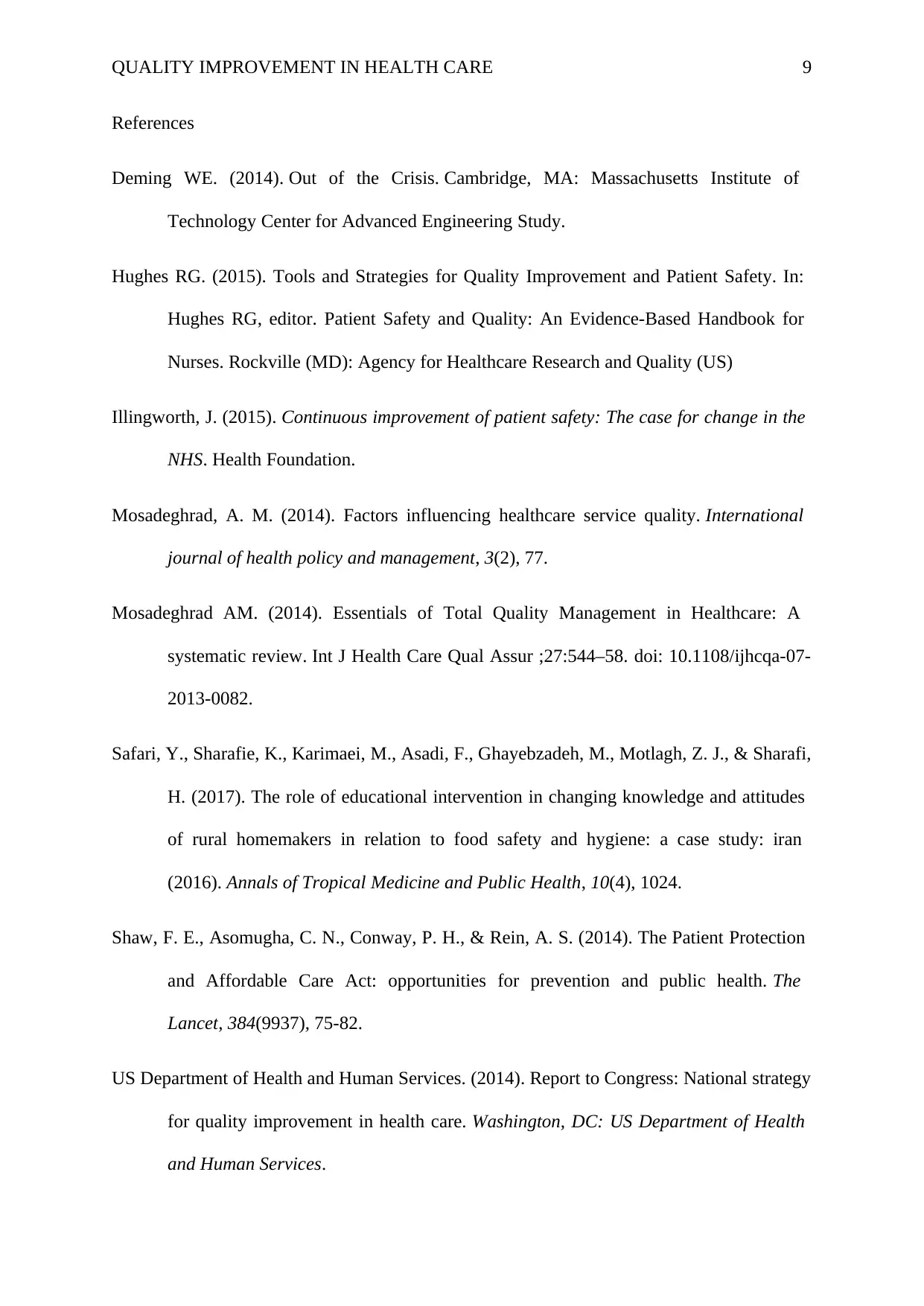
QUALITY IMPROVEMENT IN HEALTH CARE 9
References
Deming WE. (2014). Out of the Crisis. Cambridge, MA: Massachusetts Institute of
Technology Center for Advanced Engineering Study.
Hughes RG. (2015). Tools and Strategies for Quality Improvement and Patient Safety. In:
Hughes RG, editor. Patient Safety and Quality: An Evidence-Based Handbook for
Nurses. Rockville (MD): Agency for Healthcare Research and Quality (US)
Illingworth, J. (2015). Continuous improvement of patient safety: The case for change in the
NHS. Health Foundation.
Mosadeghrad, A. M. (2014). Factors influencing healthcare service quality. International
journal of health policy and management, 3(2), 77.
Mosadeghrad AM. (2014). Essentials of Total Quality Management in Healthcare: A
systematic review. Int J Health Care Qual Assur ;27:544–58. doi: 10.1108/ijhcqa-07-
2013-0082.
Safari, Y., Sharafie, K., Karimaei, M., Asadi, F., Ghayebzadeh, M., Motlagh, Z. J., & Sharafi,
H. (2017). The role of educational intervention in changing knowledge and attitudes
of rural homemakers in relation to food safety and hygiene: a case study: iran
(2016). Annals of Tropical Medicine and Public Health, 10(4), 1024.
Shaw, F. E., Asomugha, C. N., Conway, P. H., & Rein, A. S. (2014). The Patient Protection
and Affordable Care Act: opportunities for prevention and public health. The
Lancet, 384(9937), 75-82.
US Department of Health and Human Services. (2014). Report to Congress: National strategy
for quality improvement in health care. Washington, DC: US Department of Health
and Human Services.
References
Deming WE. (2014). Out of the Crisis. Cambridge, MA: Massachusetts Institute of
Technology Center for Advanced Engineering Study.
Hughes RG. (2015). Tools and Strategies for Quality Improvement and Patient Safety. In:
Hughes RG, editor. Patient Safety and Quality: An Evidence-Based Handbook for
Nurses. Rockville (MD): Agency for Healthcare Research and Quality (US)
Illingworth, J. (2015). Continuous improvement of patient safety: The case for change in the
NHS. Health Foundation.
Mosadeghrad, A. M. (2014). Factors influencing healthcare service quality. International
journal of health policy and management, 3(2), 77.
Mosadeghrad AM. (2014). Essentials of Total Quality Management in Healthcare: A
systematic review. Int J Health Care Qual Assur ;27:544–58. doi: 10.1108/ijhcqa-07-
2013-0082.
Safari, Y., Sharafie, K., Karimaei, M., Asadi, F., Ghayebzadeh, M., Motlagh, Z. J., & Sharafi,
H. (2017). The role of educational intervention in changing knowledge and attitudes
of rural homemakers in relation to food safety and hygiene: a case study: iran
(2016). Annals of Tropical Medicine and Public Health, 10(4), 1024.
Shaw, F. E., Asomugha, C. N., Conway, P. H., & Rein, A. S. (2014). The Patient Protection
and Affordable Care Act: opportunities for prevention and public health. The
Lancet, 384(9937), 75-82.
US Department of Health and Human Services. (2014). Report to Congress: National strategy
for quality improvement in health care. Washington, DC: US Department of Health
and Human Services.
⊘ This is a preview!⊘
Do you want full access?
Subscribe today to unlock all pages.

Trusted by 1+ million students worldwide

QUALITY IMPROVEMENT IN HEALTH CARE 10
World Health Organization. (2016). Quality of care: a process for making strategic choices in
health systems.
World Health Organization. (2016). Quality of care: a process for making strategic choices in
health systems.
1 out of 10
Related Documents
Your All-in-One AI-Powered Toolkit for Academic Success.
+13062052269
info@desklib.com
Available 24*7 on WhatsApp / Email
![[object Object]](/_next/static/media/star-bottom.7253800d.svg)
Unlock your academic potential
Copyright © 2020–2025 A2Z Services. All Rights Reserved. Developed and managed by ZUCOL.





